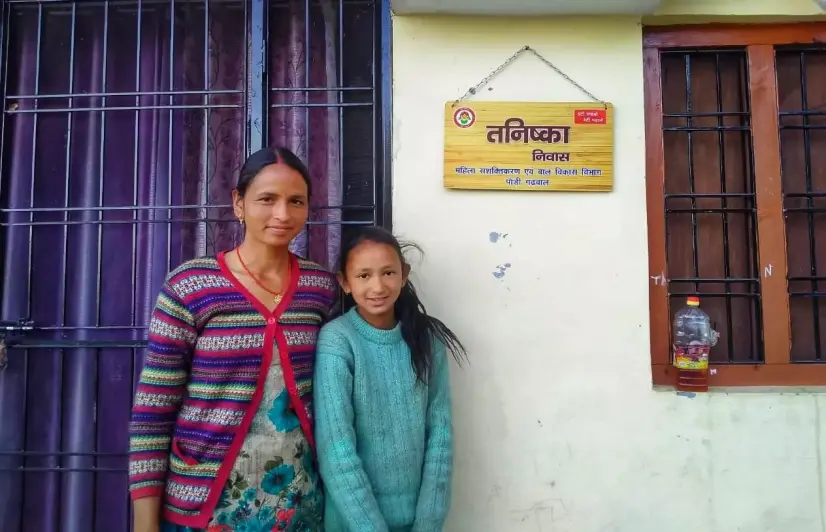Initiative to name homes after daughters brings cheer in Uttarakhand

Initiative to name homes after daughters brings cheer in Uttarakhand
Dehradun, Uttarakhand: What’s in a name? Shakespeare didn’t think much of names but for 15-year-old Himani Bisht, her name is a source of pride and power. “My younger brother always used to say that our house belongs to him. I will get married one day and go away. But now I tell him this house is mine,” the Class 11 student says while drawing our attention to the nameplate outside her home in Pauri. ‘Himani Niwas’, it reads in Hindi.
At
a little distance from Himani's house is ‘Tanishka Niwas’. The
house is named after the youngest daughter of the family, Tanishka
Rawat. “I like my nameplate very much,” the Class 6 student
giggles.
Since
October last year, hundreds of homes in the Pauri Garhwal district of
Uttarakhand have been displaying plaques named after their daughters.
They are acting on an initiative taken by Pauri District Officer
Dhiraj Garbyal to create awareness about property ownership among
women, as granted by The Hindu Succession(Amendment) Act, 2005. It
also aims to foster gender equality in Uttarakhand, a state whose sex
ratio was less than 900 as per the 2016-18 data.
The
initiative is called ‘Ghaurki pachyan, Nauni ku Nau’ and
translates to ‘Identity of the house in the name of the daughter’.
It has now spread to the Kumaon region as well, thanks to Garbyal
again. After he got posted to Nainital as its district magistrate
last month, he launched a similar programme called ‘Gharai ki
Pehchan Chelik Naam’. The Uttarakhand government has lent full
support to the initiative and plans to distribute these nameplates to
about 7,000 families in Nainital in the first phase of the scheme.
'Small
things, big change'
Sociologists
in the region have welcomed the move. Social change often begins with
small attitudinal shifts, they say.
Professor
Vidya Singh, who is the convenor of Dhad Cultural Society in
Dehradun, explains, “Naming the home after girls may not seem like
a big deal to elders. But it can give a sense of security to girls.
That’s because as soon as girls grow up, they are made to believe
their home is not theirs, it belongs to their father. And the home
they go to after marriage is their husband’s or father-in-law’s, they are told.”
Singh
has observed that though The Hindu Succession (Amendment) Act, 2005,
gives equal
rights to daughters to inherit family property, “it doesn’t seem
to have made much impact.” Perhaps because of the lack of
initiatives to sensitise women about the importance of this
legislation, Supreme Court lawyer Arti Singh says in this report.
“The
nameplate will give girls the mental strength to claim their rights.
When girls return from school, they will be excited to see their name
on the door,” Singh feels.
A young Sonakshi poses with the nameplate named after. Credit: Mahesh Pal
In fact, owning even a small plot of land/immovable property can reduce a woman’s risk of domestic violence and poverty, Bina Agarwal, who’s authored the award-winning book A Field of One’s Own: Gender and Land Rights in South Asia, has found in her research.
For
women, by women
These
nameplates are empowering women in more ways than one. Most of these
nameplates are being made by women who are part of Minakriti — The
Aipan Project, an initiative to promote the Kumaoni folk art of
Aipan.
For
the uninitiated, Aipan is a free-style drawing done on the walls and
floor of brick red colour. The rice flour paste (biswar) that is used
to draw the patterns lends a white contrast. These Aipan-style
nameplates are further decorated with beads and trinkets,
22-year-old Meenakshi Khati from Nainital, who has started this
initiative, informs.
"Earlier Aipan was mostly done during festivals and on special occasions but now Aipan can be found outside the homes [permanently, on nameplates]," Khati tells us proudly.
Currently,
15 women from her hometown Ramnagar work on this Aipan project on a
full-time basis. They are mostly homemakers and they make anywhere
between Rs5,000 and Rs6,000 per month from this vocation. Sometimes,
school-going girls chip in too and take home Rs2,000-Rs3,000.
‘It
brings respect to girls’
As
for Garbyal, he hopes that the nameplate scheme would inspire the
society to treats girls at par with men and give them the agency to
inherit the ancestral property.
Himani Niwas is named after the youngest daughter of the house, Himani Bisht. Credit: Mahesh Pal
"This will bring more respect to girls," feels Himani's mother, Hema Devi, who's happy to have the nameplate named after her daughter. "I want my daughter to become independent. I don't want her to be a burden on anyone," she goes on to add.
While
the initiative is intended to empower young girls, married women are
waiting for their turn too. "I would have liked it if the
nameplate of our house bore my name. But it's my husband's house,"
Tanishka's mother, Sadhna, tells us with a gentle smile.
Indeed
there is something powerful about the question: 'Is this your house?'
Would you like to Support us
101 Stories Around The Web
Explore All NewsAbout the Reporter
Write For 101Reporters
Would you like to Support us
Follow Us On



